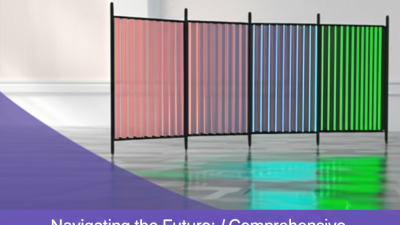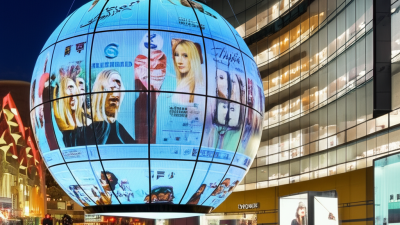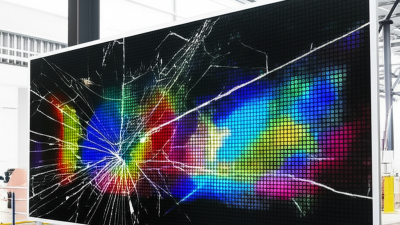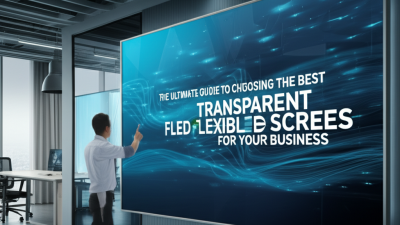
-
Home
-
Products
-
About Us
-
Case
-
News
-
BLOG
-
FAQ
-
Contact Us
Leave Your Message

In recent years, the advent of Flexible Transparent LED Film Screens has marked a revolutionary shift in the realm of interior design, bridging the gap between technology and aesthetics. These innovative screens not only enhance visual appeal but also introduce a level of interactivity that was previously unimaginable in physical spaces. Industry expert Dr. Emily Hudson, a leading authority in digital display technologies, emphasizes this transformation, stating, "Flexible Transparent LED Film Screens are not just tools; they are artistic canvases that redefine how we engage with our environment."
As architects and designers embrace this technology, the possibilities seem endless. From retail spaces that use these screens to create immersive shopping experiences, to offices that integrate them for subtle branding and dynamic information sharing, the applications are vast and varied. The ability to use these screens seamlessly within a space allows for a unique fusion of functionality and creativity. In this exploration, we will delve into the top five ways Flexible Transparent LED Film Screens are redefining interior design, showcasing their potential to change how we perceive and interact with our surroundings.

Flexible transparent LED film screens are poised to revolutionize interior design, offering innovative applications that blend aesthetics with functionality. The global market for transparent conductive films is projected to grow significantly, from $7.00 billion in 2025 to an impressive $12.35 billion by 2032, reflecting a compound annual growth rate (CAGR) of 8.5%. This surge indicates a robust demand driven by advancements in display technologies and their increasing integration into everyday environments.
Recent trends in display technology emphasize the evolution toward micro-LEDs and transparent, free-form displays. These innovations are not merely theoretical; they are becoming indispensable in various sectors, from retail spaces that incorporate dynamic visual merchandising to residential settings that use these screens as versatile design elements. Furthermore, developments in materials science, such as the creation of highly conductive, printable transparent plastics, are enhancing the functionality and versatility of these screens. As these technologies continue to advance, they hold the potential to redefine how we perceive and interact with our living and working spaces.
With the rise of flexible transparent LED film screens, interior design is undergoing a transformative shift. These innovative screens can seamlessly integrate into various interior spaces, offering dynamic ways to display visuals without compromising the aesthetic appeal. As we look towards 2025, trends suggest an increasing incorporation of light as an integral design element—aligning with the potential of these LED screens to enhance environments in both functional and artistic ways.
For designers looking to incorporate LED screens into their projects, consider these tips: First, utilize LED screens to create zones within open-plan spaces by displaying different visuals that reflect the specific mood or functionality of each area. Secondly, layer lighting by combining natural and artificial sources, allowing the LED screens to complement ambient lighting while becoming a focal point. Lastly, ensure that the placement of these screens enhances the overall flow of the space, as a well-thought-out arrangement can make the technology feel less intrusive and more a part of the room's design narrative.
As homeowners and designers alike seek to blend technology with creativity, flexible LED screens stand out as a versatile solution. Not only do they provide a platform for artistic expression, but they also align with the latest trends in interior lighting, making them an essential component for future design projects.
Flexible transparent LED film screens are changing the way we think about interior design by allowing for dynamic lighting and vibrant visuals that directly influence the ambiance of a space. These innovative screens can be integrated into windows, walls, and other surfaces, creating immersive environments that adapt to the moods and needs of the occupants. For example, a living room can transform from a calming retreat with soft blue hues during the day to a vibrant party space with colorful animations in the evening. This adaptability not only enhances aesthetic appeal but also affects how people feel and interact within a space.
Additionally, the functionality of a room is significantly enhanced with the use of these LED screens. They can display essential information, such as weather updates or schedules, while also serving as art pieces or entertainment hubs. In commercial settings, businesses can utilize these screens for advertising and engaging customers in a visually stimulating manner. The integration of transparent LED technology means that these displays don’t obstruct the view or light but instead blend seamlessly into the design, allowing for a multifunctional space that meets various needs while setting the desired mood.
| Design Element | Key Feature | Influence on Mood | Functional Benefits |
|---|---|---|---|
| Lighting Control | Adjustable brightness and color | Can create a calming or energizing atmosphere | Enhances productivity and relaxation |
| Dynamic Displays | High-resolution visuals with flexibility | Engages occupants through visual appeal | Versatile use in presentations and entertainment |
| Environmental Adaptation | Transparent when not in use | Maintains openness and spaciousness | Maximizes light flow and space utilization |
| Interactive Elements | Touch and motion-sensitive screens | Encourages engagement and participation | Improves user interaction and experience |
The emergence of flexible transparent LED film screens is revolutionizing the interior design landscape, with a strong emphasis on sustainability and energy efficiency. Recent advancements suggest that transparent displays can reduce energy consumption significantly and provide dynamic visual solutions for various environments, from retail spaces to luxury homes. For instance, a report projects that the adoption of energy-efficient display technologies could reduce operational costs by up to 30%, while also minimizing the carbon footprint associated with traditional lighting options.
Tips for integrating transparent LED film into your design plans include considering the placement of these displays to enhance natural light flow, as well as utilizing them in areas where interactivity is beneficial. When deciding on the content to display, choose high-resolution visuals that engage users while reinforcing the space's intended atmosphere.
With the global market for transparent displays expected to reach $10 billion by 2027, leveraging this technology not only positions businesses at the forefront of innovation but also aligns with growing consumer demand for sustainable practices. By incorporating transparent LED technology, designers can create immersive experiences that are visually striking and environmentally responsible.
As flexible transparent LED film screens become a cornerstone of modern interior design, the future of LED technology holds exciting prospects. A recent report from the National Kitchen & Bath Association highlights that LED lighting will dominate bathroom designs in 2025, appealing to Gen Z's preference for minimalism and calm spaces. This trend aligns closely with the increasing demand for multifunctional and interactive home environments, where lighting plays a crucial role in enhancing mood and functionality.
Tips: When incorporating LED technology into your interior spaces, consider using dimmable options to create versatile atmospheres that can shift from vibrant to serene. Additionally, explore integration with smart home systems to customize lighting based on daily activities and preferences.
Moreover, design experts predict that by 2026, experiential and sustainable lighting solutions will shape our living spaces. The emphasis on artisanal techniques combined with innovative illumination technology reflects a growing desire for personalized and thoughtful home environments. As we embrace these changes, flexible LED screens not only provide aesthetic appeal but also contribute significantly to energy efficiency, ushering in a new era of interior design that harmonizes technology and artistry.
Tips: For those looking to stay ahead of trends, consider opting for energy-efficient LED films that can be easily adjusted for different uses, such as home cinemas or dynamic art displays, maximizing both practicality and creativity in your design choices.





